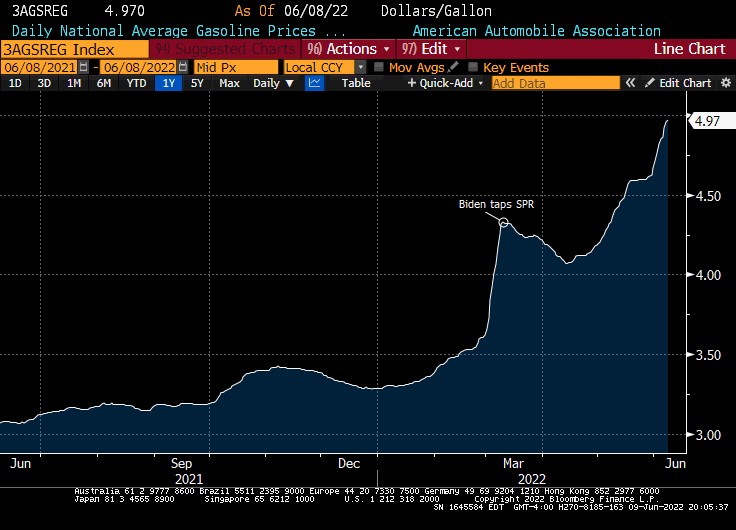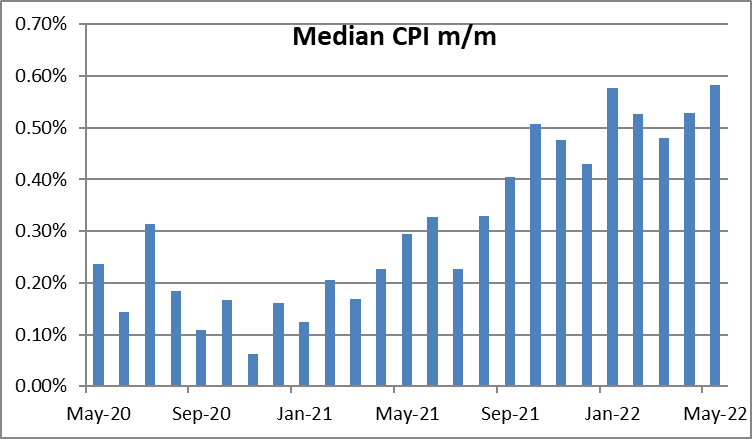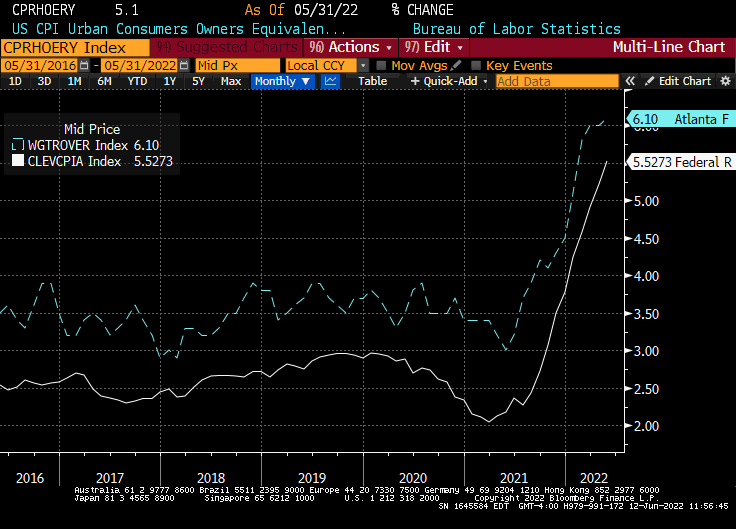This article was written exclusively for Investing.com
And here, we all thought that CPI was at least at a local peak. The interbank market, prior to Friday’s report, was already trading forward CPI prints at levels that implied “Peak CPI” was yet to come, but few thought it would happen so soon. And yet, Friday’s report put the y/y headline CPI at 8.6%, besting March’s much celebrated figure.
Obviously, a lot of the impetus for the new peak came from the persistent rise in gasoline prices, which continued their relentless increase after a brief pause in recognition of Biden’s flush of oil from the Strategic Petroleum Reserve. Of note, the Administration on Friday announced that it has inquired from industry about how it can help improve refinery output. (The gasoline market immediately dropped, which illustrates that there are a lot of traders who don’t realize that building a new refinery is a decade-long process that hasn’t been done in the US since 1972. The crude oil market also immediately dropped, which illustrates that there are a lot of traders who don’t realize that increasing refinery throughput would increase crude oil demand on the front end. Or, perhaps, this trading was all done by stupid bots interpreting the headline as bearish, which is my guess.)

But the Core CPI was also higher than expected. It came in below the earlier peak but nonetheless demonstrates that this is not entirely about gasoline.
After difficult comps from May and June 2021, core CPI faces easy comps in July, August, and September. Another peak is thus probably likely in core CPI as well. Also, slower/better measures like Median CPI continue to accelerate. And price pressures are not yet ebbing.

The data itself showed a continuation of recent trends: increasing shelter inflation and a general broadening of inflation so that it is now infecting most of the consumption basket. In other words, we are all getting poorer.
The good news, such as it is, is that wages are accelerating and are at least reflecting some of the increased cost of living. The spike in food and energy is not being passed through, but at least the rise in median inflation is getting into wages. Well, that’s good in the short term, if you’re one of those getting a wage increase, but it also reinforces the upcycle.
In the following chart, the dotted line is the Atlanta Fed Wage Growth Tracker and the white line is median CPI.

Now, naturally, once the recession arrives and there is a bigger pool of available labor, it will become harder for workers to keep up. And a recession is, of course, coming.
Yes, unemployment is low and the economy is still growing. But it would be a truly amazing thing if a doubling of oil prices and a spike in interest rates was not followed by a recession—either of those things has been known to cause an economy to contract and I am not aware of any time that both happened and we did not experience recession.
However, remember that recession is not a cure for inflation. Just look to the 1970s to see a counterexample. The central bank must contract the money supply to do so—and, for the first time since the advent of modern central banking, the Fed is attempting to slow inflation by changing interest rates and not by restricting reserves.
This doesn’t seem like a great time for such an experiment, but when you have no idea what you’re doing, every day is an experiment.
Taking a Step Back…
Inflation conspiracy nuts are fond of pointing out that the government made a significant change to the calculation of CPI in the early 1980s and that therefore inflation is really much higher than the government claims. It’s nonsense, which I’ve taken down elsewhere, but it is true that the Bureau of Labor Statistics (BLS) has changed the CPI over the years and did make a major change in the early 1980s.
These changes have generally been improvements, and the 1983 change to the treatment of Owner-Occupied Housing corrected some major problems with CPI. Notably, prior to the change mortgage interest was taken to be a major component of shelter costs. But housing is both an investment good and a consumption good, and including the financing cost of owning the asset was inappropriate…not only that, doing so meant that when the Fed was tightening CPI would mechanically go up (because it included interest rates!) and when the Fed was easing CPI would mechanically fall.
We have known this, obviously, since the 1970s and the 1983 correction to the method was the result of a public, decade-long research and analysis process (not a change made in a smoky back room by the Illuminati, as some would have you believe). But it does mean that the inflation of today is not directly comparable to the inflation of the late ‘70s/early ‘80s.
In a brilliant paper published last week (one characteristic of a brilliant paper is that it makes the reader think, “why didn’t I think about doing that?”), Marijn Bolhuis, Judd Cramer, and Larry Summers (yes, that Larry Summers) took today’s methodology and applied it backwards to see where inflation would have been in the last inflation crisis, had current methodologies been used then.
It is an easy paper to read and worth the time. And here is the upshot:
- Inflation in the 1980s was not as high as we thought at the time.
- Unfortunately, that means we are much closer to those highs than we would think, comparing CPI to CPI.
- Moreover, inflation today is likely to be stickier, because more of the consumption basket is in sticky items (like housing) than in flexible items like food and apparel, etc.
The upshot of this is that interest rates are going to have to go higher than the market currently expects that they will; higher than the Federal Reserve has previously said they would need to (with the “dot plot” peaking around 2.75%). And, they will need to stay there longer. This is bad news for stocks and bonds, neither of which is incorporating an outcome remotely that bad. And, of course, it’s bad news for all of us.
This entire inflation episode has seemed like one of those old commercials where, just when you think you’ve heard the whole pitch, Ron Popeil says “don’t answer yet! Just look what else you get!” Well, it seems that we are going to keep getting it. And we probably don’t have to wait 6-8 weeks for delivery.
***
Michael Ashton, sometimes known as The Inflation Guy, is the Managing Principal of Enduring Investments, LLC. He's a pioneer in inflation markets with a specialty in defending wealth against the assaults of economic inflation, which he discusses on his Cents and Sensibility podcast.
